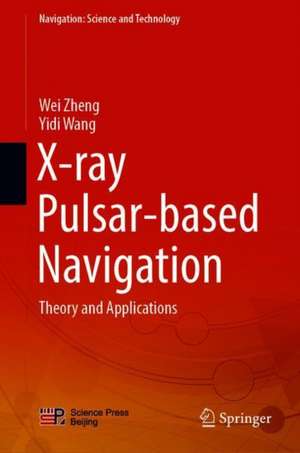X-ray Pulsar-based Navigation: Theory and Applications: Navigation: Science and Technology, cartea 5
Autor Wei Zheng, Yidi Wangen Limba Engleză Hardback – 18 apr 2020
| Toate formatele și edițiile | Preț | Express |
|---|---|---|
| Paperback (1) | 637.46 lei 6-8 săpt. | |
| Springer Nature Singapore – 18 apr 2021 | 637.46 lei 6-8 săpt. | |
| Hardback (1) | 643.65 lei 6-8 săpt. | |
| Springer Nature Singapore – 18 apr 2020 | 643.65 lei 6-8 săpt. |
Preț: 643.65 lei
Preț vechi: 757.24 lei
-15% Nou
Puncte Express: 965
Preț estimativ în valută:
123.18€ • 127.25$ • 102.52£
123.18€ • 127.25$ • 102.52£
Carte tipărită la comandă
Livrare economică 26 martie-09 aprilie
Preluare comenzi: 021 569.72.76
Specificații
ISBN-13: 9789811532924
ISBN-10: 9811532923
Ilustrații: XII, 222 p. 149 illus., 137 illus. in color.
Dimensiuni: 155 x 235 mm
Greutate: 0.51 kg
Ediția:1st ed. 2020
Editura: Springer Nature Singapore
Colecția Springer
Seria Navigation: Science and Technology
Locul publicării:Singapore, Singapore
ISBN-10: 9811532923
Ilustrații: XII, 222 p. 149 illus., 137 illus. in color.
Dimensiuni: 155 x 235 mm
Greutate: 0.51 kg
Ediția:1st ed. 2020
Editura: Springer Nature Singapore
Colecția Springer
Seria Navigation: Science and Technology
Locul publicării:Singapore, Singapore
Cuprins
Introduction.- X-ray pulsar signal processing.- X-ray pulsar/multiple measurement information fused navigation.- Ground-based simulation and verification system for X-ray pulsar-based navigation.
Notă biografică
The authors serve on the Flight Dynamics and Control Team at the National University of Defense Technology, which is one of the leading teams on X-ray pulsar-based navigation in China. They have been studying the theory and methodology of X-ray pulsar-based navigation since 2004.
Textul de pe ultima copertă
This book discusses autonomous spacecraft navigation based on X-ray pulsars, analyzing how to process X-ray pulsar signals, how to simulate them, and how to estimate the pulse’s time of arrival based on epoch folding. In turn, the book presents a range of X-ray pulsar-based spacecraft positioning/time-keeping/attitude determination methods. It also describes the error transmission mechanism of the X-ray pulsar-based navigation system and its corresponding compensation methods. Further, the book introduces readers to navigation based on multiple measurement information fusion, such as X-ray pulsar/traditional celestial body integrated navigation and X-ray pulsar/INS integrated navigation. As such, it offers readers extensive information on both the theory and applications of X-ray pulsar-based navigation, and reflects the latest developments in China and abroad.
Caracteristici
Introduces not only the basic concept of X-ray pulsar-based navigation, but also specific application methods Covers virtually every aspect of X-ray pulsar-based navigation and offers readers a complete picture of X-ray pulsar-based navigation Provides ideas for how to realize X-ray pulsar-based navigation and to enhance its positioning accuracy, including aspects like the on-orbit processing pulsar signal, handling pulsar timing noise, and compensating for various systematic biases













